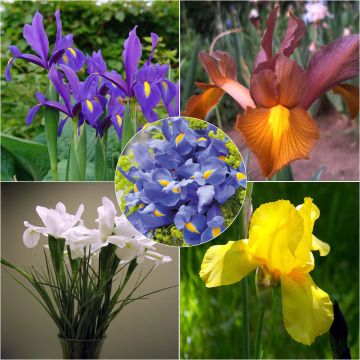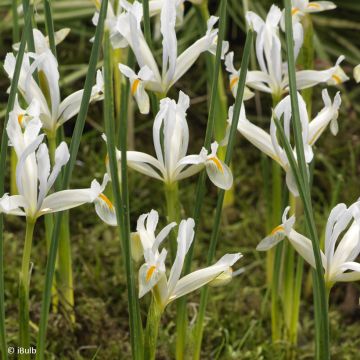

Chionodoxa forbesii Blue Giant


Chionodoxa forbesii Blue Giant


Chionodoxa forbesii Blue Giant


Chionodoxa forbesii Blue Giant


Chionodoxa forbesii Blue Giant


Chionodoxa forbesii Blue Giant


Chionodoxa forbesii Blue Giant
Chionodoxa forbesii Blue Giant
Chionodoxa forbesii Blue Giant
Glory-of-the-snow, Squill
Pretty flower but you made a mistake regarding the quantity. I ordered 70 for £60, and you sent me packages of 15 containing only 5 blooms!
Sandra, 20/10/2022
Special offer!
Receive a €20 voucher for any order over €90 (excluding delivery costs, credit notes, and plastic-free options)!
1- Add your favorite plants to your cart.
2- Once you have reached €90, confirm your order (you can even choose the delivery date!).
3- As soon as your order is shipped, you will receive an email containing your voucher code, valid for 3 months (90 days).
Your voucher is unique and can only be used once, for any order with a minimum value of €20, excluding delivery costs.
Can be combined with other current offers, non-divisible and non-refundable.
Home or relay delivery (depending on size and destination)
Schedule delivery date,
and select date in basket
This plant carries a 6 months recovery warranty
More information
We guarantee the quality of our plants for a full growing cycle, and will replace at our expense any plant that fails to recover under normal climatic and planting conditions.
Would this plant suit my garden?
Set up your Plantfit profile →
Description
Chionodoxa forbesii Blue Giant is slightly larger than other Glory of the Snow varieties. Like them, it blooms early in spring, with star-shaped flowers in a beautiful sky blue color with a white centre, emerging from slightly darker green foliage than other varieties. This small bulbous plant can be described as having a good character, simplicity, and freshness. It easily naturalises under trees, at the base of bushes, or even in containers, eventually forming abundant colonies over time. Stunning among daffodils and botanical tulips!
Endemic to the mountains of southwestern Turkey, at altitudes above 2500m (8202ft), this small perennial bulbous plant belongs to the hyacinth family and is a close relative of hyacinths. The Chionodoxa forbesii Blue Giant, sometimes called Chionodoxa luciliae hort., is a slightly larger and less common form of this plant, typically blooming in azure blue. It forms small clumps of 20 cm (8in) in height when in bloom, spreading indefinitely thanks to the production of numerous bulblets, eventually forming beautiful shining carpets. In February-March-April, depending on the climate, its delicate sky blue stars with white markings at the centre celebrate the departure of the last snow for two weeks. From a bulb, sometimes several purplish stems bearing 3 to 10 small flowers will emerge. Its foliage is ribbon-like, dark green, sometimes tinged with purple at the tips, deciduous from May-June.
Chionodoxa was once a very popular plant, somewhat neglected in recent years. However, it is a flawless plant, easy to grow in cool or alpine climates, very hardy, and a welcome sight after winter. Its bright flowers spread out in flowering carpets alongside liverworts, hyacinths, squills, and botanical tulips. It will naturalise in sunny rockeries, but also under deciduous trees and shrubs, in partial shade. It is advisable to plant it close to the edges, due to its low height, as this plant can successfully emerge through a carpet of baby's tears, creating a very successful combination. Chionodoxas are also very interesting for use in pots.
Chionodoxa forbesii Blue Giant in pictures




Plant habit
Flowering
Foliage
Botanical data
Chionodoxa
forbesii
Blue Giant
Hyacinthaceae
Glory-of-the-snow, Squill
West Asia
Other Chionodoxa
View all →Planting and care
Plant Chionodoxa forbesii Blue Giant from September to November at a depth of about 5 cm (2in) and with a spacing of 8-10cm (3-4in). Plant a little closer together in pots. You can leave the bulbs in place for several years: beautiful clumps will form. Chionodoxa can be forced indoors like Crocuses.
Chionodoxa luciliae will thrive in a sunny or semi-shady location. While it tolerates any ordinary soil, it should still be loose, well-draining, and moist. The bulbs should not be completely dry during the summer. This small bulbous plant declines in excessively hot climates.
Cultivating in pots: Plant the bulbs in a mixture of good garden soil, compost, and a bit of coarse sand. Be careful not to let the soil in the pots dry out in the summer.
Planting period
Intended location
Care
Planting & care advice
-
, onOrder confirmed
Reply from on Promesse de fleurs
Similar products
Haven't found what you were looking for?
Hardiness is the lowest winter temperature a plant can endure without suffering serious damage or even dying. However, hardiness is affected by location (a sheltered area, such as a patio), protection (winter cover) and soil type (hardiness is improved by well-drained soil).

Photo Sharing Terms & Conditions
In order to encourage gardeners to interact and share their experiences, Promesse de fleurs offers various media enabling content to be uploaded onto its Site - in particular via the ‘Photo sharing’ module.
The User agrees to refrain from:
- Posting any content that is illegal, prejudicial, insulting, racist, inciteful to hatred, revisionist, contrary to public decency, that infringes on privacy or on the privacy rights of third parties, in particular the publicity rights of persons and goods, intellectual property rights, or the right to privacy.
- Submitting content on behalf of a third party;
- Impersonate the identity of a third party and/or publish any personal information about a third party;
In general, the User undertakes to refrain from any unethical behaviour.
All Content (in particular text, comments, files, images, photos, videos, creative works, etc.), which may be subject to property or intellectual property rights, image or other private rights, shall remain the property of the User, subject to the limited rights granted by the terms of the licence granted by Promesse de fleurs as stated below. Users are at liberty to publish or not to publish such Content on the Site, notably via the ‘Photo Sharing’ facility, and accept that this Content shall be made public and freely accessible, notably on the Internet.
Users further acknowledge, undertake to have ,and guarantee that they hold all necessary rights and permissions to publish such material on the Site, in particular with regard to the legislation in force pertaining to any privacy, property, intellectual property, image, or contractual rights, or rights of any other nature. By publishing such Content on the Site, Users acknowledge accepting full liability as publishers of the Content within the meaning of the law, and grant Promesse de fleurs, free of charge, an inclusive, worldwide licence for the said Content for the entire duration of its publication, including all reproduction, representation, up/downloading, displaying, performing, transmission, and storage rights.
Users also grant permission for their name to be linked to the Content and accept that this link may not always be made available.
By engaging in posting material, Users consent to their Content becoming automatically accessible on the Internet, in particular on other sites and/or blogs and/or web pages of the Promesse de fleurs site, including in particular social pages and the Promesse de fleurs catalogue.
Users may secure the removal of entrusted content free of charge by issuing a simple request via our contact form.
The flowering period indicated on our website applies to countries and regions located in USDA zone 8 (France, the United Kingdom, Ireland, the Netherlands, etc.)
It will vary according to where you live:
- In zones 9 to 10 (Italy, Spain, Greece, etc.), flowering will occur about 2 to 4 weeks earlier.
- In zones 6 to 7 (Germany, Poland, Slovenia, and lower mountainous regions), flowering will be delayed by 2 to 3 weeks.
- In zone 5 (Central Europe, Scandinavia), blooming will be delayed by 3 to 5 weeks.
In temperate climates, pruning of spring-flowering shrubs (forsythia, spireas, etc.) should be done just after flowering.
Pruning of summer-flowering shrubs (Indian Lilac, Perovskia, etc.) can be done in winter or spring.
In cold regions as well as with frost-sensitive plants, avoid pruning too early when severe frosts may still occur.
The planting period indicated on our website applies to countries and regions located in USDA zone 8 (France, United Kingdom, Ireland, Netherlands).
It will vary according to where you live:
- In Mediterranean zones (Marseille, Madrid, Milan, etc.), autumn and winter are the best planting periods.
- In continental zones (Strasbourg, Munich, Vienna, etc.), delay planting by 2 to 3 weeks in spring and bring it forward by 2 to 4 weeks in autumn.
- In mountainous regions (the Alps, Pyrenees, Carpathians, etc.), it is best to plant in late spring (May-June) or late summer (August-September).
The harvesting period indicated on our website applies to countries and regions in USDA zone 8 (France, England, Ireland, the Netherlands).
In colder areas (Scandinavia, Poland, Austria...) fruit and vegetable harvests are likely to be delayed by 3-4 weeks.
In warmer areas (Italy, Spain, Greece, etc.), harvesting will probably take place earlier, depending on weather conditions.
The sowing periods indicated on our website apply to countries and regions within USDA Zone 8 (France, UK, Ireland, Netherlands).
In colder areas (Scandinavia, Poland, Austria...), delay any outdoor sowing by 3-4 weeks, or sow under glass.
In warmer climes (Italy, Spain, Greece, etc.), bring outdoor sowing forward by a few weeks.



















































